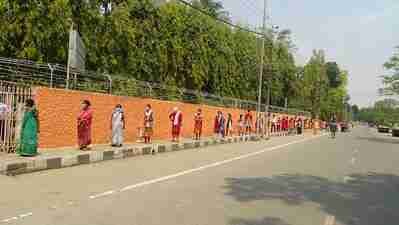COVID crisis is causing unimaginable human and economic losses. The crisis will adversely impact globalisation, shrink -if not completely disrupt supply chains, reduce the growth of global trade, and investment. This unprecedented shock to the global system caused by the crisis is likely to reorder economic relationships, political forces (within and between countries), and balances of power.
Impacts of the crisis of global politics will play out through three broad themes: perceived success or failure of governments in managing the crisis; measures taken by leaders for exploiting the crisis for global political gains; and the perceived failure of the multilateral system in responding to the crisis. Duration of the crisis and the severity of its impacts will determine how these three themes reshape global politics.
State of play of global politics
The US has called out China and Russia as revisionist powers presenting a wide variety of economic, political, counterintelligence, military, and diplomatic challenges to the US and its allies. With an “America First” approach, Trump administration has challenged China in the areas of trade and the economy, technological dominance, military advancement, and control over the Indo-Pacific rimland.
The crisis will adversely impact global markets, shrink -if not completely disrupt supply chains, reduce the growth of global trade, and investment.
China is on a rapid path to amass all the required material capabilities of a major power to change the balance of power in the Indo-Pacific region, and perhaps globally in the long-run. Under President Putin, Russia has returned as a global player, leverage China-US strategic competition to its advantage. Russia has deepened its cooperation with China, especially in the energy, military, and technology spheres. The Indo-Pacific region has become a theatre of major powers’ politics, the ramifications of which will be global.

India is the only leading power with potential material capabilities that can block China from seeking dominance over the Indo-Pacific rimland. Significant diplomatic, financial, defence, and strategic investments are being made by India to shape the external environment for enhancing her national interest.
The US and India have been making progress on strategic and military fronts but struggling to align their economic interests in a way that benefits both. The bilateral relationship between India and China has grown more complex over the years with elements of both competition and cooperation. Informal Leaders’ Summit and the purchase of S400 by India has been the highpoint in strategic and security relationship between Russia and India in the past few years.
COVID and strategic competition among major powers
The three major powers, the US, China, and Russia, are using the crisis as an opportunity to gain a competitive advantage more so than enhancing cooperation. The decisions made by leaders in the coming months and years will reshape world politics.

United States
COVID-19 has killed more Americans than the Vietnam War. The unprecedented human suffering and economic pain caused by COVID crisis are likely to force leaders in the US to take strong measures against China in the coming months and years.
Trump administration, with the support of U.S. Senate and Congress, is working to impose a series of political and economic sanctions, visa restrictions on students and nationals, tariffs, and export controls, on China. Some reshoring of manufacturing capacity and stockpiling of essential commodities is likely to happen in the US and its allies in the post-crisis era.
Internationally, the US is also building a coalition to corner China for its perceived mismanagement of the crisis.
China Hawks and Presidential Campaign teams have banded together during the crisis with sharp anti-China rhetoric. No matter if Trump or Biden wins the elections, a hard China policy seems to be in the offing. Internationally, the US is also building a coalition to corner China for its perceived mismanagement of the crisis. Given domestic political implications of the crisis, US allies in Europe and Asia are likely to support a hard China policy.
The US and its allies scrutiny of multilateral institutions, especially UN and its agencies, for their China bias will intensify in the coming years. There is a serious risk that further political, technology and economic decoupling could slow growth in the US, its allies, and China, and in the process, increasing security competition in Indo-Pacific. On the other hand, a potential reduction in defence spending to soften the financial pains is likely to constrain the US and its allies’ capabilities for power projections in Indo-Pacific.
China
The Crisis has not turned out to be China’s “Chernobyl”. It is also projected that economic recovery in China is more likely to be faster and broad-based than any other economies in G20. Fiscal stimulus measures will further expand the role of SOEs in the Chinese economic in a post-crisis era.
The crisis will likely not have a disruptive impact on supply chain linkages with China. It is more likely that only low-cost manufacturing supply chains would shift from China to other countries in South-East and South Asia. However, some reshoring of manufacturing capacity and stockpiling of essential commodities is likely to happen in the US and its allies in the post-crisis era.
BRI has taken on a new avatar of a Health Silk Road. Like the post-Global Financial Crisis, China is likely to exploit public and private sector debt situation in Eastern & Central European and Asian countries for strategic share purchases in key infrastructure sectors. China will likely remain on track for realising its Made in China Vision 2025, civil-military fusion and BRI initiatives.
Chinese propaganda efforts for shaping the domestic and global narrative on the origin of COVID -19 and crisis response management will only intensify.
Russian and China strategic cooperation is also likely to be strengthened. Chinese propaganda efforts for shaping the domestic and global narrative on the origin of COVID -19 and crisis response management will only intensify. China is likely to double down on efforts to gain influence in the multilateral institutions, including the UN and its agencies.
For continued signalling of her geopolitical ambitions, China is not shying away from flexing its muscles in the Indo-Pacific region. All these trends point to an intense strategic competition between China and the US, leading to a fierce geopolitical rivalry in the Indo-Pacific.
Russia
As the crisis deepens in Russia, President Putin could suffer a loss in public support. Reduced energy export earnings will also put an enormous strain on the economy. A combination of these factors is likely to lead to a hardening of the Russian authoritarian model. Russia has been making a plea at the UN and G20 for lifting international sanctions to ease economic pain. However, domestic politics in EU and the US make it highly unlikely to allow for any relief in the near term.
Under these circumstances, and as Russia battles the impacts of the crisis, Russia-China entente may evolve into a formal alliance, complicating global politics and creating more security challenges for the US and its allies.
Strategic Choices for India
The crisis would expedite the pace and scope of strategic competition between the US, China, and Russia to cover all domains of statecraft. This would increasingly constrain the strategic autonomy strategy of India to strike bargains with these major powers. On the other hand, the crisis response measures taken under the decisive leadership of PM Modi, firmly established his credentials as a strong leader globally.

This offers the PM significant currency to navigate the headwinds of global geopolitics with confidence. Under the campaign of self-reliance, efforts are needed on geo-economic, security and political domains to strengthen the capabilities of the State and its bureaucratic machinery to manage the expected surge in strategic competition amongst US, China, and Russia for geopolitical dominance.
Strengthening security cooperation in the Indo-Pacific
Enhanced maritime cooperation with the US allies: the US more likely to use security agreements with India to create dilemmas for the country’s military and push for a net security provider role in the Indo-Pacific. India should leverage the domestic political compulsions among US’ NATO allies, for a tougher stance on China to strengthen maritime cooperation with France and the UK. Working with these countries, India could also craft a broader strategy to engage Russia in the Indo-Pacific.
Expedite defence modernisation efforts
The GoI needs to expeditiously implement its plan for reducing defence forces personnel strength while modernising the defence forces. Measures to reduce military spending on personnel and social benefits would increase financial headroom for modernising military and procurement of advanced weapons. With Russia undergoing economic stress, India could also explore purchasing advanced missile defence systems from Russia.
Safeguard energy security
The US may double down on its maximum pressure tactics on Iran to exploit her vulnerabilities during and post Crisis era, not to mention the increased maritime tensions in the South China Sea with China. The heightened maritime conflict environment could increase the spectre of naval blockades in Strait of Hormuz and Straits of Malacca.
India has strategic oil reserves for only 9 days, and under these potential developments, it should aim to expand its strategic reserves capacity and lock- in long-term oil and LNG contracts with Saudi Arabia, United Arab Emirates and Russia, which are experiencing economic stress due to Crisis.
Leveraging shifting global politics for economic growth, real economic opportunities are also expected to arise from domestic political pressures in the US and its allies to reduce dependence and vulnerabilities to China. The US and its allies are providing fiscal incentives for shifting part of supply chains out of China. In a low-interest rate and low-growth environment in the US and its allies, capital flows will also be chasing high-investment grade opportunities in emerging markets.
The crisis has also fast-tracked digitisation of economies but also increase vulnerabilities to cyber-attacks, creating new economic opportunities in the cybersecurity sector.
Cashing the digital acceleration
To cash into an extreme acceleration in the digital economy and increased vulnerabilities to cyber-attacks, the GoI can forge an aggressive strategy with India’s IT giants for expanding services export. IT industry could build and offer cybersecurity workforce to respond to the global demand. No other country can offer such skilled, tested, and reliable workforce.
The GoI could also position India as a big and curated data generator for AI and related applications which has huge commercial value, promoting technologies for offering personalised services at scale. The heightened anxieties about China may provide an opportunity for India to tap into these “new economy growth opportunities”.
Shifting of supply chains and investment flows
Unless there is a strong push from the government, it is highly unlikely that any supply chains, capital flows and investments moving out of China would naturally shift to India. The GoI can strengthen the mandate of Invest India to actively engage with global brands to attract supply chain that may be moving out of China. Similarly, NIIF could actively tap into the deep reserves of SWF of Norway, UAE and others.
The Govt can work with RBI to issue Diaspora bonds to offset a drop-in remittance flow. Diaspora bonds could also be linked to financing infrastructure projects. Finally, the GoI needs to create a system to foster competition amongst Indian PSUs on the lines of Chinese SOEs’ model.
Stockpiling of critical supplies
The US and its Allies will be reshoring manufacturing of critical supplies, including pharmaceuticals and Active Pharmaceutical Ingredient (APIs). GoI can provide fiscal incentive to push for innovation in generics, biopharma, and genetic engineering.
Strengthening geo-economic toolkit
Competition for influence by the US and China at the UN and its agencies will intensify in the coming years. Leaving the US and China to fight at the UN and its agencies, India could rather consider making strategic investments for expanding influence in global financial institutions, like IMF, WB and MDBs.
This will continue to bring much needed low-cost investments in India on one hand and open-up new trade and co-investment opportunities for the Indian industries in other developing countries. Expanding strategic partnership with WB and MDBs will also pay dividends as India prepares to host the G20 in 2022. The Ministry of Finance and the Ministry of External Affairs could conduct a joint review of India’s strategic positioning at the UN and IFIs. Specific opportunities to strengthen the Government’s geo-economic toolkit are as follows:
- Seeking membership in Inter-American, and Caribbean Development Banks could also enhance trade engagement opportunities in Latin America.
- Strengthening the balance sheet of EXIM Bank and expanding its mandate for co-financing investments in connectivity projects with MDBs will also help in expanding exports.
- In debt driven scenario in Africa, make targeted efforts to turn soft power into investment opportunities for Indian companies for connectivity projects; Work with the US, UK, Germany, and France to jointly finance projects in Asia – Africa Growth Corridor.
- Working with France, Germany, and the UK, through the Alliance for Multilateralism, strengthen the ISA and the CDRI, for establishing leadership on the global climate change agenda.
New Model of Economic Cooperation with China
Intensifying strategic competition between the US and its allies, and China in the post-crisis era may offer a strategic opening to India to enhance its economic cooperation with China. With increased scrutiny on Chinese investment in the US and its allies, India could explore a grand bargain with China to strengthen economic cooperation while managing its competition in the Indo-Pacific region. The economic cooperation framework used by Japan and China in the 1970s may offer useful insights to Indian policymakers.
In this new model of economic cooperation, India could progressively consider inviting Chinese FDI in non-critical infrastructure projects on mutually agreed terms. Acknowledging that BRI initiative is here to stay, and likely expand, India, like Australia, could also consider joint investments in some of the mega-connectivity BRI projects on a mutually agreed term.
There may also be an opportunity to cut a deal with China for lower trade barriers against Indian goods and services to rebalance bilateral trade deficit. In the coming years, India and China could upgrade the profile of India-China Strategic Economic Dialogue (SED) to a Finance and Foreign Ministers’ Two Plus Two format to forge and guide a stronger economic cooperation partnership.


